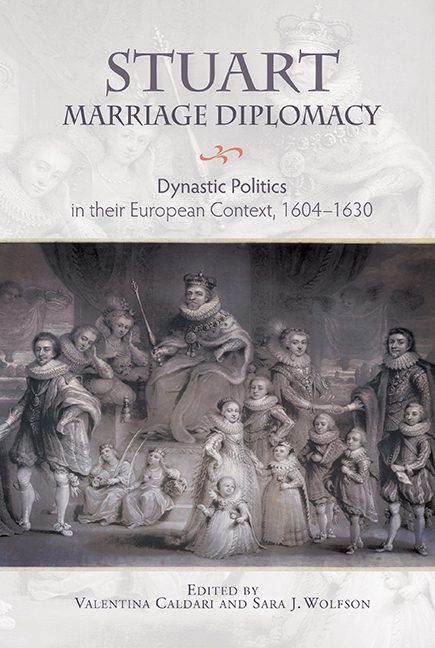Book contents
- Frontmatter
- Contents
- List of Illustrations
- List of Contributors
- Acknowledgements
- List of Abbreviations
- Introduction
- Part One Marriage and the Court
- Part Two Marriage and Politics
- Part Three Marriage and War
- Part Four Marriage and News
- Part Five Marriage and Continental Europe
- 15 A Peace in Context: Spanish Change in Italian Affairs
- 16 The Court in Brussels: From Hostility to ‘good vicinity’ (1585–1604)
- 17 The Austrian Match: The Habsburgs’ Dynastic Alternative and European Politics
- Part Six Marriage and Ceremony
- Bibliography
- Index
- Studies in Early Modern Cultural, Political and Social History
17 - The Austrian Match: The Habsburgs’ Dynastic Alternative and European Politics
from Part Five - Marriage and Continental Europe
Published online by Cambridge University Press: 24 October 2019
- Frontmatter
- Contents
- List of Illustrations
- List of Contributors
- Acknowledgements
- List of Abbreviations
- Introduction
- Part One Marriage and the Court
- Part Two Marriage and Politics
- Part Three Marriage and War
- Part Four Marriage and News
- Part Five Marriage and Continental Europe
- 15 A Peace in Context: Spanish Change in Italian Affairs
- 16 The Court in Brussels: From Hostility to ‘good vicinity’ (1585–1604)
- 17 The Austrian Match: The Habsburgs’ Dynastic Alternative and European Politics
- Part Six Marriage and Ceremony
- Bibliography
- Index
- Studies in Early Modern Cultural, Political and Social History
Summary
The courts in London and Madrid were not alone in the debate around the wedding of Prince Charles Stuart and Maria Anna of Austria. The Spanish infanta had in fact another prominent suitor, her cousin Archduke Ferdinand, son of the Roman emperor Ferdinand II. Ferdinand succeeded and the couple were married in 1629.
Already by the 1610s, as the negotiations for the Anglo-Spanish match were developing, a parallel and competing negotiation was being carried out by the proponents of an alternative, Austrian match. Such a marriage fulfilled a traditional political project of dynastic allegiance and confessional firmness. A micropolitical analysis enables to show how an influential dynastic network was established between the courts in Madrid and Vienna, supported by the papacy. In this Catholic triangle, members of the dynasty, high courtiers and papal agents maintained a fluid contact and developed a group identity. Advocacy for the Austrian match and a refusal to a further an alliance with England was one of their shared goals.
Nevertheless, the road to the Austrian Match was far from trouble free. While a dynastic network eased the contacts between Madrid and Vienna, from 1620 the official agendas of the two courts were increasingly divergent. Indeed, at that moment in the Thirty Years’ War, the Spanish monarchy radically opposed the attempt of the Austrian monarchy and the papacy to transfer the imperial electoral vote from the Palgrave to the duke of Bavaria. The other main disruptive factor was French policy and the efforts of the other great Catholic king, Louis XIII of France, not to remain isolated. After years of uncertainty, the new ministry of Richelieu attempted to attract former allies of the Habsburgs, such as Bavaria or England. Thus, the negotiations for a potential Austrian match offer a thread by which to understand the complex dynastic and personal nature of early modern European diplomacy.
Introduction
On the morning of 18 March 1623, the news of the arrival of Prince Charles and the duke of Buckingham at the court in Madrid quickly spread across the city. The papal nuncio Massimi speedily took two decisions: he wrote to the royal favourite Olivares to demand an immediate audience and sent an indirect message to Infanta Maria Anna.
- Type
- Chapter
- Information
- Stuart Marriage DiplomacyDynastic Politics in their European Context, 1604–1630, pp. 271 - 284Publisher: Boydell & BrewerPrint publication year: 2018



